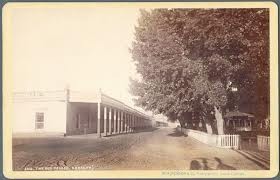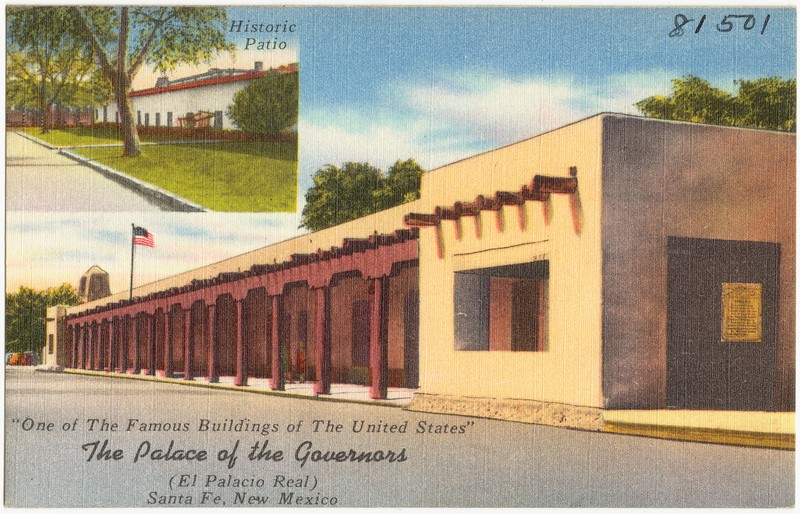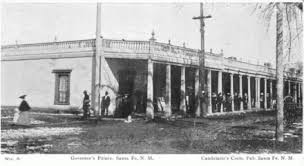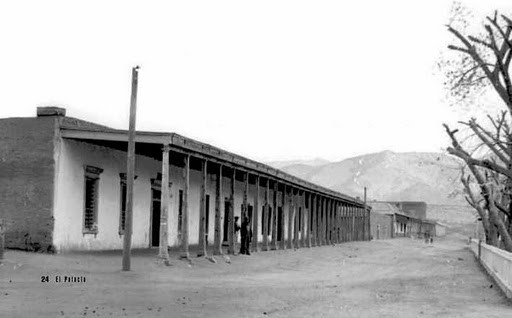Palace of The Governors
Introduction
Text-to-speech Audio
Images
The Palace of The Governors in 1881

Post Card

Note some architectural changes. Railing on top of building.

Older picture without railings.

Backstory and Context
Text-to-speech Audio
Mexico gained its independence from Spain in 1821. The Palace of the Governors became the seat of government for the Mexican province of Nuevo Mexico. In 1837, the Chimayó Rebellion erupted in New Mexico. A group of Natives and disgruntled settlers captured and executed Mexican Governor Albino Perez. General Amarijo regained control and executed the rebellion’s leaders.5
On August 18, 1846, three months after the U.S. declared war on Mexico, 1,500 U.S. troops marched into Santa Fe’s Plaza. Stopping in front of the Palace of the Governors, the columnn took control of the city. The city’s residents listened quietly as the commander addressed the crowd,
“I, Stephen W. Kearny, General of the Army of the United States, have taken possession of the province of New Mexico. In the name of the government of the United States, I hereby instruct the inhabitants to deliver their arms and surrender absolutely… I am your governor--look to me for protection.”6
The era of U.S. control had begun. In 1847 the legislature, under American control, began to meet in the Palace.7 Kearny established Fort Marcy on a hilltop near the city center as a means to control the area.8
The Palace of the Governors continued to serve as the capitol until 1850 when New Mexico first sought to attain statehood. A new capitol building was built in 1885 and the last governor of the New Mexico Territory to live in the Palace left in 1909. The 400-year-old building is the oldest extant building constructed by European settlers in the continental U.S.9 It has been renovated to reflect its original southwestern appearance. The Palace of the Governors is now part of the New Mexico Museum of History. One of the museum's better known exhibits is displayed in the Palace of the Governors. The Segesser Hide Paintings portray the history of early New Mexico.Sources
2. Bradley, Glen Danford “The Story of the Santa Fe”, (Boston: Richard G. Badger, The Gorham Press, 1920), accessed March 28, 2015, GooglePlay
3. Read, Benjamin M, “The History of Santa Fe in 1000 Words”, (Santa Fe Trail Magazine, Vol. 1 No. 1, 1913) accessed March 28, 2015. GooglePlay
4. Read, Benjamin M, “The History of Santa Fe in 1000 Words”
5. Read, Benjamin M, “The History of Santa Fe in 1000 Words”
6. Merry, Robert W., “A Country of Vast Designs”, (New York: Simon & Schuster, 2009), p. 293
7. National Park Service, American Latino Heritage, “Palace of the Governors Santa Fe, New Mexico”
8. Prince L. Bradford, “Old Fort Marcy: Santa Fe, New Mexico”, (Santa Fe: New Mexican Printing Co., 1912), accessed March 28, 2015, GooglePlay
9. National Park Service, American Latino Heritage, “Palace of the Governors Santa Fe, New Mexico”
